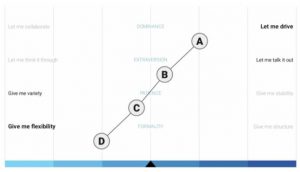Want a Thriving Business? Focus on Employee Behaviour
By Michaela Picones |
2.3 min read

In this modern work world, we spend 50% of our active day working. The movement towards work-life flexibility is important but due to technology, instant connectivity is expected, and we are never truly “logged-off”. As our work and life become more integrated, “better work, better world” is looking more to be (should be) a worldwide mission.
Understanding people and behavior is not as hard as it use to be, thanks to the work of psychologists and scientists, we have “people” data. Employee behaviors are the natural ways in which coworkers and collaborate. Taking the time to understand yourself and those around you is crucial into understanding how you contribute to the bigger picture (bottom line). As a leader, you need to understand your people, so you know who to put on the court. The world isn’t black and white and you can’t view your employees in the typical “good” vs. “bad” binary lens. “Good” vs. “bad” employees, what does that even mean? Each individual in your organizations contributes in one form or another, if your talent is not aligned with your business strategy, it will be harder for you to see that.
Types of Workplace Behaviour
At The Predictive Index, our scientists measure workplace behavior according to four key drives:
Dominance: the drive to exert influence on people or events (a.k.a., the A drive)
Extraversion: the drive for social interaction with other people (a.k.a., the B drive)
Patience: the drive to have consistency and stability (a.k.a., the C drive)
Formality: the drive to conform to rules and structure (a.k.a., the D drive)
Think of each of these four drives as its own spectrum, with a high end, a low end, and a midpoint.

Take the behavioral pattern on the left. An employee with this pattern has high dominance (high A), high extraversion (high B), low patience (low C), and low formality (low D). True to these drives, this person might be perceived as assertive and outgoing, with a need for variety and flexibility.
As mentioned, these spectrums don’t serve to measure integrity. High does not equate to “good,” just as low does not mean “bad.” But by understanding where an employee falls for each of these drives, you can get a clearer picture of that person’s overall behavioral makeup—and what might motivate them at work.
By understanding your people, you can maximize your business. Productivity, employee motivation, improved collaboration, is what talent optimization is all about. Interested in the how, connect with one of our talent optimization consultants here.
References:
https://www.predictiveindex.com/blog/demystifying-employee-behaviors/
Related Blogs
How to Decide Who to Layoff?
How to Decide Who to Layoff? A Strategic Guide Powered by The Predictive Index In uncertain economic climates, tough decisions often become necessary for business continuity. One of the most challenging decisions any organization faces
HR Risk Management – Full Guide
HR Risk Management: A Full Guide with The Predictive Index Advantage In today’s volatile business environment, human capital remains one of the greatest assets—and one of the biggest risks. Organizations are navigating an increasingly complex
9 Tips for Hiring the Best Salesperson
9 Tips for Hiring the Best Salesperson (Backed by The Predictive Index) Hiring the right salesperson can feel like trying to find a needle in a haystack. Sales is a high-stakes role where the right



